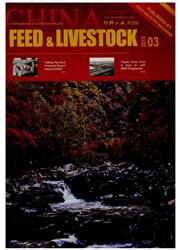

 中文摘要:
中文摘要:
为了了解不同粒径颗粒饲料真空喷涂油脂后的储存特性,试验选择三种不同粒径(Φ2.5 mm、Φ3.5 mm、Φ4.5 mm)的生长猪硬颗粒饲料为研究对象,经真空喷涂油脂后用聚乙烯自封袋包装,并分别置于自然条件(北京,4月至7月)和高温高湿条件(恒温恒湿培养箱,温度30℃、相对湿度80%)下储存,在储存期90 d内每隔15 d取样测定一次指标,并进行感官评价。结果显示:粒径越大饲料开始霉变的时间越早;饲料水分含量整体呈现先降低后升高的趋势,且粒径越大水分含量开始升高的时间越早,升高的幅度也越大,同一采样时间水分含量除初始值外均随粒径的增大而显著升高(P〈0.05);饲料水分活度的变化规律与水分含量基本相同;脂肪酸值在自然条件下随时间延长逐渐升高,在高温高湿条件下随时间延长先升高后降低,且粒径越大脂肪酸值开始降低的时间越早,变化的速度和幅度也越大;过氧化值在自然条件下随时间延长先降低后升高,在高温高湿条件下随时间延长先降低后升高最后又降低,粒径越大过氧化值变化的速度和幅度越大;丙二醛含量与过氧化值有关,而粒径对其的影响没有呈现规律性。结果表明:不同粒径饲料在储存期间各指标的变化趋势基本相同,但粒径会影响各指标变化的速度和幅度。粒径越大,饲料水解酸败和氧化酸败的速度越快,饲料开始霉变的时间也越早。
 英文摘要:
英文摘要:
In order to research storage features of pellet feed of different particle size after oil vacuumspraying, hard pellet feed of three different particle size(Φ2.5 mm, Φ3.5 mm and Φ4.5 mm) for grow-ing pigs was selected. The feed was packaged in polyethylene valve bags after oil vacuum spraying,and then stored in conditions of nature(Beijing, April to July) and high temperature-high humidity(30 ℃, 80%) for 90 d, respectively. During the period of storage the samples were analyzed every 15 dand at the same time sensory evaluation was done. Results showed that the bigger the particle sizewas, the more early the feed mildewed. The moisture content decreased first and then increased on thewhole, and the bigger the particle size was, the more early the moisture content began to rise and thebigger the raise range was. Except the initial value, the moisture content at the same sampling time in-creased significantly along with the increase of particle size(P〈0.05). The change law of water activitywas similar with that of moisture content on the whole. In natural condition, fatty acid value increasedgradually as time went on. While, in the condi-tion of high temperature-high humidity fatty ac-id value rose first and then fell, and the biggerthe particle size was, the earlier the fatty acidvalue began to fall and the bigger the range andrate of the change were. Peroxide value, in natu-ral condition, decreased first and then increased,while, in condition of high temperature-high hu-midity it decreased again at last. The bigger the particle size was, the bigger the range and rate of the change were. Malondialdehyde content was relat-ed to the peroxide value, and the influence of particle size on it was not regularity. Results indicatedthat the indexes of different particle size of feed had the same change trends, while, the particle size af-fected the range and rate of that change. The bigger the particle size, the more rapidly the hydrolyticand oxidative rancidity and the more early the feed mildewed.
 同期刊论文项目
同期刊论文项目
 同项目期刊论文
同项目期刊论文
 期刊信息
期刊信息
